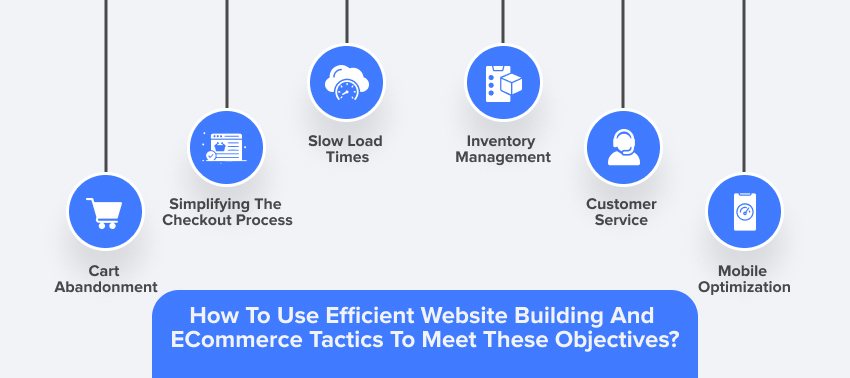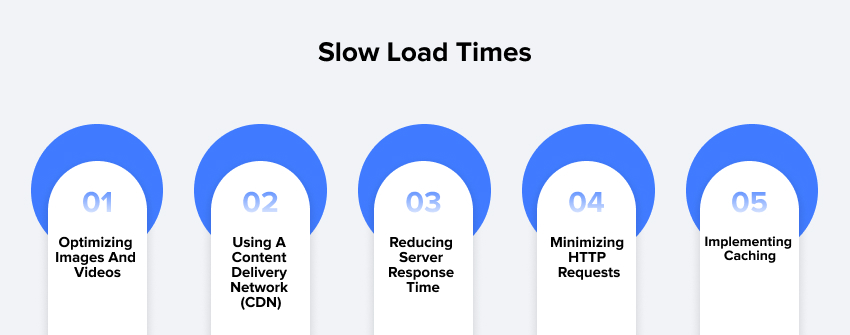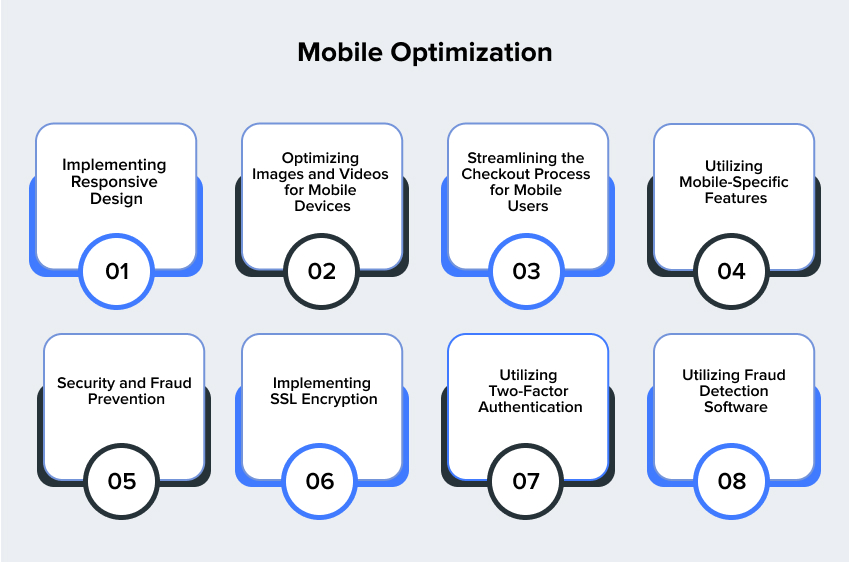The success of any eCommerce solution company depends on streamlining the ecommerce experience through a well-designed and user-friendly website in today’s competitive market. Various factors, including Cart Abandonment Solutions, Mobile Responsive Design, and Personalization in E-commerce, must be focused on during the development of a website for eCommerce.
In today’s digital landscape, having an efficient eCommerce solution is essential for businesses. With the increasing number of online consumers, businesses must prioritize website optimization and streamline the eCommerce process. This is crucial to reduce cart abandonment rates and enhance overall customer satisfaction.

How to Use Efficient Website Building and ECommerce Tactics to Meet These Objectives?
Cart Abandonment
Cart abandonment is a significant issue for online retailers. It occurs when a buyer initiates an online purchase but decides to back out before checking out. Cart abandonment is a significant source of lost income and potential customers for online merchants. According to statistics from the Baymard Institute, almost 70% of shopping carts are left unfilled.

Cart abandonment has a variety of financial effects for online retailers. The impact on income stands out the most. When a customer chooses to remove items from their shopping basket, a transaction is lost. In addition, if the checkout process is overly difficult or lengthy. Customer satisfaction may decline as a result of cart abandonment.
Online retailers can use a number of different tactics to persuade customers to finish their purchases. This group includes the following techniques:
Simplifying The Checkout Process:
The checkout procedure needs to be simplified, as this is one of the leading causes of cart abandonment. Organizations may make things easier for their customers by streamlining the buying process. Collecting only the information they need, and communicating with them clearly at every step.
Offering Guest Checkout: Many customers are hesitant to make an account on a new website. So if you force them to do so at checkout, they may leave their purchase. Businesses can make it simpler for clients to complete their purchases by providing a guest checkout option.
Providing Multiple Payment Options: Consumers have varying preferences when it comes to making purchases. Therefore, providing a variety of payment methods can boost conversion rates. Credit cards, PayPal, and Apple Pay are all common ways to pay online.
Offering Free Shipping and Returns: Free shipping help you close more sales because people sometimes hesitate to buy because of the high shipping. Since customers don’t have to worry about return fees or shipping costs, they’re more inclined to purchase.
Providing Clear and Detailed Product Information: Consumers want as much information as possible before purchasing. You can earn their trust and business by giving it to them in the form of clear, extensive product information. Content such as product descriptions, reviews, pictures, and videos are all fair game.
Slow Load Times

Slow load times greatly affect ecommerce businesses as customers tend to abandon websites that take too long to load. In fact, a survey reveals that 53% of smartphone users will leave a site if it exceeds three seconds to load.
[You may like to read: Benefits of Using Professional WordPress Page Speed Optimization Service]
There are several ways in which slow load times hurt online stores. The effect on customers’ happiness is most noticeable. Customers may feel frustrated and decide not to purchase from a slow-loading website.
This may cause a drop in sales and patronage. Furthermore, as search engines like Google consider page load times when deciding a site’s ranking, bad load times can have a detrimental impact on search engine optimisation (SEO).
E-commerce businesses can use a variety of techniques to quicken page loads and improve the user experience for their customers. Examples of such techniques include:
Optimizing Images and Videos:
Furthermore, as search engines like Google consider page load times when deciding a site’s ranking, bad load times can have a detrimental impact on search engine optimisation (SEO).

E-commerce businesses can use a variety of techniques to quicken page loads and improve the user experience for their customers. Examples of such techniques include:
Using a Content Delivery Network (CDN):
Using a content delivery network (CDN) distributes website content across multiple servers, enhancing website loading speed.
Reducing Server Response Time: The length of time it takes for a page to load is significantly influenced by how quickly a server responds to a request.
To improve server response time, businesses can rely on a reliable host, optimize server settings, and minimize requests.
Minimizing HTTP Requests: Reduce the number of HTTP requests your site makes to load elements like photos, scripts, and stylesheets. The longer it takes for a web page to load, the more HTTP requests it makes.
Businesses can optimize page loading by merging files, minimizing script and stylesheet sizes, and using inline images.
Implementing Caching: Caching is implemented by storing frequently accessed material, such as images and scripts, on the user’s local machine or in the browser’s cache. By lowering the number of server queries, load times can be drastically improved. Caching is a useful tool for businesses, and it may be implemented in several ways.
Inventory Management

Inventory management is crucial for running a successful online store. It helps prevent stockouts or excessive inventory, ensuring customer satisfaction and maximizing profits. Effective inventory management is particularly important in e-commerce, where businesses need to balance stock availability with storage costs. Lack of visibility into inventory levels can lead to challenges, especially when selling across multiple channels.
There are several approaches that e-commerce enterprises can take to inventory management that will help them overcome these obstacles. Among these methods are:
Utilizing Inventory Management Software: It enables e-commerce businesses to monitor inventories in real-time across all of their sales channels. This can assist retailers in keeping the right amount of goods on hand and rapidly meeting customer demand.

Businesses can maintain stock levels and promptly identify expired or surplus items that need to be liquidated thanks to inventory management software, which also offers other advantages.
Implementing Automated Inventory Tracking: Automate inventory management for e-commerce businesses to effortlessly track stock and eliminate manual monitoring. Barcode readers and radio-frequency identification (RFID) readers are two examples of automated inventory monitoring technology that can be used to keep tabs on stock and whereabouts.
Utilizing Demand Forecasting Tools: To anticipate future product demand and modify stock levels accordingly, e-commerce enterprises might use demand forecasting technologies.
The proper amount of inventory is on hand at all times, thanks to demand forecasting technologies that utilize past sales data, market trends, and other factors to predict future demand.
Utilizing Drop Shipping: Drop shipping is a method in which an online retailer forms a partnership with a wholesaler to fulfil client orders. This can help e-commerce companies save money and time often spent on warehousing and handling inventory. The supplier distributes the goods directly to the client, and the e-commerce company gets a cut of the sale price.
Customer Service

E-commerce companies, like any other, must prioritize providing excellent customer service. Customers’ lack of confidence and hesitation about online purchases might be attributed to the inability to physically inspect and try on things.
Excellent customer service can alleviate these issues, win customers’ trust and devotion, and enhance their overall satisfaction. Online shops can use the following methods to provide their clients with better service.
Offering Multiple Support Channels: It’s a good idea to make yourself accessible via email, phone, and live chat because customers might appreciate having the option to reach you via the channel of their choosing. It’s possible that some customers may prefer to communicate by email to telephone. Live chat is becoming more and more popular since it makes it easy to communicate with clients right away.
Customers can choose the support channel most likely to yield a quick answer, therefore providing various options can assist in improving response times.
Providing Fast and Personalized Responses: The key to excellent customer service is responding quickly and individually to each inquiry. Delays in responding to customer questions or complaints might irritate them and leave them feeling unimportant.
Using the customer’s name and making references to their prior experiences with the company are two simple ways to start building rapport and providing a better service experience. Avoid using automated responses because they come out as robotic and impersonal.
Implementing Self-Service Options: The number of support inquiries can be reduced and the customer experience enhanced by using self-service tools such as a frequently asked questions page, knowledge base, or chatbot.
Customers can get their questions answered without waiting for a representative to get back to them when they use self-service options. As a result, support staff will be able to devote more time and energy to answering the most complicated consumer questions.
Utilizing Customer Feedback for Continuous Improvement: E-commerce enterprises can learn a lot about their consumers’ wants and requirements, as well as where they can make improvements, by collecting and analyzing customer feedback.
A company’s customer service procedures can always benefit from hearing direct input from customers in the form of surveys, star ratings, and reviews. Businesses can increase customer happiness and loyalty by responding to consumer input with improvements designed to meet their specific needs.
Mobile Optimization

Mobile devices, especially smartphones, and tablets have altered the online shopping experience. Nowadays, more than half of all online purchases occur through mobile devices. Therefore, if your e-commerce site is not mobile-friendly, you may miss out on a large percentage of potential buyers.
Optimizing your e-commerce site for mobile devices means crafting it around the needs of mobile shoppers. Among these considerations is making sure that mobile users can easily explore and enjoy your site.
A mobile-optimized website should be easy to use and include the same features as its desktop equivalent.
E-commerce enterprises can improve their mobile optimisation in a number of ways. Here are a few of the more effective techniques:
Implementing Responsive Design: A responsive layout is an essential component of mobile optimisation. The style and content of your website will automatically adjust to the user’s device if it has a responsive design. That way, your website will look amazing and function smoothly on any screen size, from mobile to desktop.
Optimizing Images and Videos for Mobile Devices: Optimize images and videos for mobile devices in your optimization strategy. This involves reducing the file size of media such as photos and movies to speed up downloads on mobile devices. Also, check to see that images and videos are shown in the appropriate aspect ratio for the viewer’s screen size.
Streamlining the Checkout Process for Mobile Users: Mobile checkout optimization is crucial for a seamless e-commerce experience. It involves ensuring safety, reducing clicks, and simplifying payment and shipping input.
Utilizing Mobile-Specific Features: e-commerce operations should leverage push alerts and other mobile-only capabilities like geolocation. Notify customers of cart items, offer personalized recommendations, and share discounts through push notifications. Additionally, you can utilize geolocation to provide location-based offers and discounts, thereby enhancing the precision of delivery estimates.
Security and Fraud Prevention: Online store operations cannot function without a focus on security and the elimination of fraud. Online retailers face security threats like data breaches, phishing, and account takeovers. Ecommerce enterprises are vulnerable to fraud due to chargebacks, identity theft, and payment fraud, all of which can result in lost income, damaged reputation, and legal responsibility.
Online retailers can take steps to safeguard customer data and prevent fraudulent transactions amidst these threats. Methods such as these are:
Implementing SSL Encryption: The online merchant secures data transit using SSL encryption.This stops cybercriminals from stealing sensitive information like credit card numbers and using it irresponsibly.
Numerous e-commerce systems have made SSL encryption a common feature due to how simple it is to implement. However, ensuring proper SSL encryption and keeping the SSL certificate current is crucial.
Two-factor authentication verifies user identity by combining a password and a one-time mobile code, enhancing account security.
Encourage consumers to enable two-factor authentication as it is often disabled by default but available on many e-commerce platforms. This security precaution helps shield internet accounts from unauthorised access.
Fraud detection software analyzes transaction data in real time, identifying and preventing fraudulent transactions by detecting unusual patterns, thus helping online retailers prevent losses.
To secure your online store from growing threats, you require customized fraud detection software, ranging from basic applications to advanced machine learning programs that identify suspicious behavior.
Providing Clear and Detailed Policies for Refunds and Chargebacks: When a customer disputes a transaction and asks their bank to reverse the charge, we refer to it as a chargeback. Chargebacks can cause major problems because to lost revenue, chargeback fees, and reputational damage. financial burden for online merchants. To prevent chargebacks, clearly communicate refund and chargeback policies to customers by prominently displaying them on the e-commerce site, promptly addressing inquiries, and proactively resolving disputes.
To Sum Up
The success of online enterprises is directly proportional to the degree to which the e-commerce experience may be simplified.
E-commerce enterprises can improve the user experience and increase conversions by addressing issues such as shopping cart abandonment and poor load times, developing a design that is responsive to mobile devices, and leveraging customization in addition to other tactics.
Businesses can stay ahead of the competition and prosper in the digital marketplace if they regularly evaluate and optimize the experience of conducting e-commerce.
FAQs
In the context of electronic commerce, we use the term “cart abandonment” to describe the scenario where a client adds products to their virtual shopping cart but then exits the website without completing the transaction.
To limit the number of times customers abandon their shopping carts while shopping online, businesses can employ methods such as streamlining the checkout process, providing customers with discounts and other forms of incentive, and sending them reminder emails.
You can improve e-commerce load times in several ways, including optimizing images and videos, reducing the number of HTTP requests made, and employing the use of content delivery networks (CDNs) to cache material.
In the context of e-commerce, “inventory management” refers to the process of tracking and managing the stock of products in an online store. This helps to ensure that there is sufficient stock to satisfy customer demand while also reducing the amount of surplus stock and the costs associated with it.
To achieve effective inventory management in an e-commerce store, you can use strategies such as setting up automated inventory tracking systems, employing forecasting tools to predict demand, and implementing just-in-time (JIT) inventory management practices.
E-commerce places a premium on providing excellent customer service because it can directly influence client retention and satisfaction levels. If you provide outstanding customer service, you may see an increase in return customers as well as favourable word-of-mouth recommendations.
To improve customer service in online retail, you can use strategies such as offering several contact channels, providing prompt and responsive help, and making interactions with clients as personalized as possible.
E-commerce businesses need to prioritize mobile optimization since an ever-increasing percentage of clients are conducting online transactions using mobile devices. Increasing mobile optimization can result in improved user experiences, which in turn can lead to a rise in conversions.
Using the adaptable design, optimizing photos and videos for mobile devices, and making use of mobile-specific features such as push notifications and geolocation are some of how businesses may improve the mobile optimization of their e-commerce stores.
To improve the security of online commerce and prevent fraud, you can utilize strategies such as using SSL encryption, applying two-factor authentication, deploying fraud detection software, and offering clear and precise regulations for refunds and chargebacks.
Related Articles
-
V-commerce – The Next Big Thing After Ecommerce and Mcommerce
Talking About V-commerce – The Next Big Thing After Ecommerce and Mcommerce, Online shopping has been acclaimed by people across the world since quite a lot of time now. It
-
Investing In Your Business’s Future With True Value Of Ecommerce App Development
With the increasing growth of ecommerce in the modern digital age, companies must keep up with the newest developments in this field. Many companies are turning to ecommerce app development
-
Seamless Way To Add Google Analytics 4 (GA4) With Magento 2
Google’s announcement that it would let go of the widely used and beloved Google Analytics Universal Analytics solution shocked the eCommerce industry recently. Normal Universal Analytics properties will stop collecting




